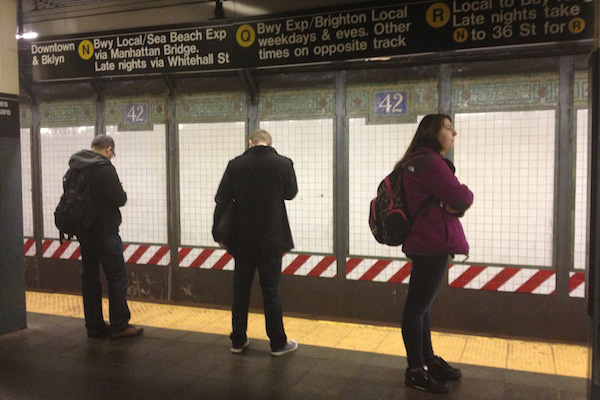
Photo by: Sophia Rosenbaum
Grand central: Subway riders stand behind the yellow line while they wait for the next southbound N or Q train.
One of the unspoken rules of New York life is that you do not talk to strangers on the subway. But the question of how to improve the MTA — which will increase fares in March — can pull riders away from their reading material.
“At rush hour I’d put more trains out, especially on the 4. Sometimes it’s so crowded you can’t breathe,” said Gemma McDonald, a babysitter who reads psalms on her daily commute to Brooklyn’s Atlantic Terminal.
William Ludolph, who underwrites municipal bonds that finance MTA improvements, looked up from his newspaper to say the agency has an image problem.
“They’re doing a pretty good job,” Ludolph said. “But do we think so? Or do most people think so? No. Most people think they’re doing a terrible job.”
Ludolph has ridden the 2 and 3 since the early 1970s. He remembers the deafening noise of trains pulling into the station in the days before the tracks were welded into place – and the frustration of waiting before countdown clocks were installed on his line.
“These are the kind of programs that they’ve been putting in for years, and at this point people take a lot of it for granted,” Ludolph said.
Tick, tock, tick, tock
At stops throughout the system, the biggest complaint from commuters seems to be the timeliness—or lack thereof.
Elsewhere, the Manhattan-bound B train platform at the Sheepshead Bay station was almost empty at 6:45 a.m. A dozen people waited for the next train.”You never know when it might come,” said Eugene Dor, who commutes every morning to Kings Highway,”so you just have to ignore your watch.”
The B train is all about time. A ride from Sheepshead Bay to Grand Street, in Manhattan, can take 45 minutes to an hour. This uncertainty drives most B train riders crazy.”If I know I have to be on the 6:45 train, I see it pass by at 6:43 or 6:42; or if I get here at 6:45, it’ll come at 6:47 or 6:48,” said Lexsy Rosario, a bilingual teacher who works in Chinatown.”I know it’s only a few minutes, but sometimes it makes the difference.”
Inevitably, the lack of explanation puzzles the riders.”When they say there’s congestion up ahead nobody knows what that means,” said Rosario.”What’s congestion? Is it traffic on the same track? We don’t understand what’s going on.”
This morning several people were tweeting about the train’s tardiness. Rebecca Kamel (@rskamel) expressed her frustration:”Ugh B train taking forrrreveeeer this morning…is this really due to fog? The weather isn’t that bad… #MTAfail.”
Trains getting stuck on the tunnel also frustrate riders.”The worst is when the train stops in the middle of the tunnel and you can’t call people to say you’re late,” said Alexa Clark, a student who commutes daily from Kings Highway to Seventh Avenue.
The madding crowd
At just before 8 a.m. a sea of people flowed through the turnstiles at Penn Station. Everyone’s goal was the same – to catch a subway during the morning rush hour.
When a train arrived at the platform for the E train, people crowded on, all of them standing. Every seat was already taken.
“It’d be good to get a seat on days like this,” said Sri Sriam, who commutes from Bridgewater, N.J. to his engineering job in Queens.
However, today was not unusual. He would stand, as usual, for most of his journey to Jamaica. The MTA lists the 34th Street-Penn Station A, C, E stop as its sixth-busiest station, with over 24 million riders a year.
At Queens Plaza the steady flow of commuters continued in both directions. Within 20 minutes, two more E trains arrived. The first was slightly less crowded; the second train much less. It was approaching nine o’clock.
Not everyone was going to work. Johann Stalars and his son boarded the E train near their Long Island City home to drop off the boy, a kindergarten student, at Most Precious Blood, a Catholic elementary school in Astoria. Stalars kept an eye and a hand on his son during the trip. “I prefer it when it’s not crowded—with him,” said Stalars.
Suggestion box
Some commuters had specific ideas for how to improve the subway.
Michelle Genao, a recent transplant from Florida studying at the Fashion Institute of Technology, has a more personal public relations campaign in mind to improve commutes. “I would have greeters because there are a lot of grumpy people in New York City for obvious reasons, and I think it would make everyone’s day,” she said.
Jessica Mitsud, who works in high-end outerwear sales and rides the J, said she enjoys reading her Nook on the train, but is sometimes interrupted by annoyances. “I hate baby carriages,” Mitsud said. “I wish they’d be forced to fold them up.”
Mitsud said she admires the subway system in London, which has Plexiglas surrounding the tracks for added safety and is impeccably clean. She doesn’t have high hopes for changes here.
“The subway is never gonna change until people appreciate the city they live in,” Mitsud said.
Ritza Yana, a visitor who lives in Washington, D.C. but grew up in New York, had plenty of suggestions to improve the subway. She said the MTA should crack down on eating and drinking on subways, install escalators at every station and go to touch-cards instead of swipe-cards to speed up entry through turnstiles.
“In D.C. you get fined for eating on the train,” Yana said. “I kind of like that because I don’t want to smell everyone’s food every day.”








